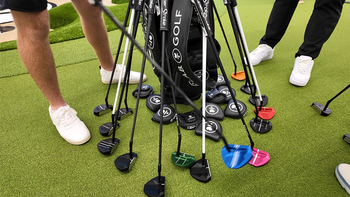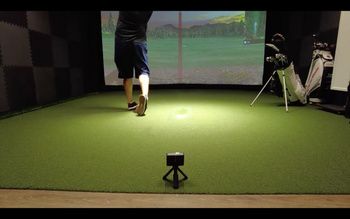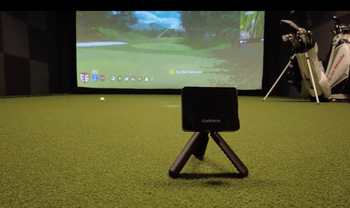Golf simulators need tall ceilings. Nine feet is the sweet spot. It gives you room to swing freely without feeling cramped. Your club will clear fixtures at its highest point, which is usually 8-9 feet for most golfers.
Think about your own swing. Everyone's is different. The angle, height, and rotation all matter. You don't want to hit the ceiling or lights when you're in full swing.
A low ceiling can ruin your simulator experience. Instead of relaxing and practicing, you'll be worried about damaging your home or hurting yourself. That's no fun at all.
When setting up your home simulator, plan for height. It's better to have extra space than not enough. You'll thank yourself later when you can practice comfortably year-round.
A roomy setup lets you host golf nights with friends too. You can all swing away without worrying about clearance issues. It makes for a much better time.
Smart planning now leads to more enjoyment down the road. Give yourself room to improve your game. With enough ceiling height, you can focus on your swing instead of your surroundings.
Understanding Ceiling Height Requirements
Golf simulator ceiling height matters more than you might think. Nine feet is the minimum you'll want for a safe, functional setup. This accommodates most golfers' swings, giving enough room to avoid hitting the ceiling.
Many overlook ceiling height when planning a simulator, but it's crucial. Too low, and you risk injury, discomfort, and damage to your equipment. Prioritizing adequate height ensures a better experience overall.
Think about your swing. Most golfers reach 8-9 feet at the top. A low ceiling forces you to change your natural motion, hurting your performance and enjoyment. You might also end up with dents in your ceiling or broken simulator parts if balls ricochet off a too-low surface.
When designing your simulator space, make ceiling height a top concern. Nine feet works for most, but taller golfers should aim for ten. This extra thought creates a safer, more effective practice environment where you can focus on improving your game without worrying about spatial constraints.
Key Dimensions for Golf Simulators
Golf simulator dimensions matter. I've learned this from experience. The right space makes practice safe and effective.
Three key measurements: ceiling height, depth, and width. Nine-foot ceilings let you swing freely. Depth affects data accuracy - you need room behind and in front. Ten-foot width gives space for equipment and a full swing.
I once used a cramped simulator at a training facility. The low ceiling and narrow space ruined my practice. It felt claustrophobic and frustrating.
My home setup is different. High ceilings, ample depth, and width. I swing confidently, focusing on technique instead of dodging walls. It's transformed my practice sessions.
Proper dimensions aren't just about comfort. They impact performance and enjoyment. A well-sized simulator creates an environment where you can truly improve your game.
Remember, every golfer's needs differ. Consider your height, swing style, and available space when planning your simulator. The goal is to replicate the feel of an actual golf course as closely as possible within your home.
Space Planning for Success

Golf simulator setup requires careful planning. I've learned the hard way that neglecting key dimensions can ruin the experience. Ceiling height, depth, and width matter. Measure your space and compare it to the simulator's specs. Don't forget to account for your swing style - a big backswing needs more room.
I've seen folks rush into setting up their simulators without proper prep. Bad move. You risk damaging equipment and ending up with a lousy setup. Trust me, it's worth taking the time to get it right.
Safety's a big deal too. You don't want to be smashing clubs into walls or ceilings. A well-planned space protects you and your gear. It also helps the simulator perform better and last longer.
Remember, everyone's needs are different. What works for your buddy might not work for you. Consider your height, swing arc, and preferred club selection. These factors influence the space you'll need.
Bottom line: measure twice, set up once. Your future self will thank you when you're enjoying smooth, worry-free indoor golf sessions.
Avoiding Common Setup Mistakes
Golf simulators need the right space. I've seen too many botched installations in cramped rooms. Low ceilings, shallow depths, and obstacles spell trouble. You risk injury, busted equipment, and a lousy experience.
Careful planning prevents these headaches. Don't just measure - think about the simulator's needs and your swing. How high should the ceiling be? What's the minimum width for a full backswing? Answer these questions before you start.
Good prep saves cash and frustration. A well-designed setup delivers accurate data and realistic play. Rush the job, and you'll end up disappointed like countless other golfers I've met.
But take your time, and you'll create something special. An immersive experience that nails the details and exceeds expectations.
Be thorough in your planning. Consider your stance, posture, and swing type. Tailor the space to fit you perfectly.
It's all about sweating the small stuff. Do it right, and you'll have a slice of golfing heaven in your own home. One that feels just like being out on the course, minus the sunburn and lost balls.
Optimizing Your Simulator Space

I'm tweaking my golf simulator setup to nail that perfect swing. It's all about getting the layout just right - positioning the simulator, net, and gear to match my style. I've got to make room for a full swing, you know? That way, I can really dig into the data and fine-tune my game.
Lighting's key too. I want to see that ball fly and feel like I'm on different courses. And let's talk air - keeping it fresh and at the right temp helps me pretend I'm actually outside.
Sound's a big deal for me. I'm cutting out distractions and pumping in some golf course vibes. It helps me zone in and really get into the game. Who knew a little basement corner could feel so much like Augusta?
Conclusion
Ceiling height reigns supreme when setting up golf simulators. Trust me, I've seen countless setups go south due to tight vertical space. You'll want at least nine feet, but taller folks need ten or more.
I team up with golf nuts to nail their simulator setup. A well-thought-out space is the ticket to an awesome golfing experience.
Ceiling height tops my list when designing simulator spaces. It's not just about dodging obstacles; it's creating a smooth experience. Golfers should focus on their swing, not ducking low-hanging stuff. Get the height right, and you have a space that feels open and comfy.
Golf simulators have specific space needs. We balance the physical game with tech requirements. I work one-on-one with clients to get their unique wants and needs. Whether it's for home or business, I craft spaces that work great and feel good.
The best simulators feel like an extension of the golf course. I aim to blur the lines between the real world and virtual play. By nailing ceiling height and other space factors, we build immersive, engaging setups that'll knock your socks off.





